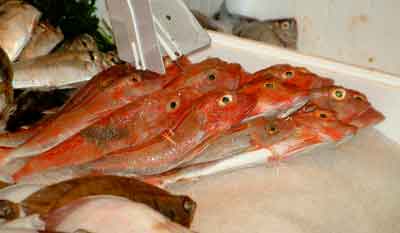Streaked gurnard. Gurnards are strange-looking, bottom-feeding fish which use the three bottom rays of their pectoral fins to "feel" the sea bed. They have firm-textured white meat with not much flavour. They are rich in protein, iodine and phosphorus. The grey gurnard (Eutrigla gurnardus) has a brownish-grey back and silver belly. The red gurnard (Aspitrigla cuculus) is the most attractive member of the family with pinkish-red colour and the finest flavour of the gurnards. The tub gurnard (Trigla lucerna) is a large brownish-orange variety with bright orange pectoral fins and is the one most readily available in the United Kingdom. There is a variety known as flying gurnard as it is a fine swimmer which sometimes leaps out of the water. They are all very bony fish. Small ones are excellent in soup. Red or grey mullet (US: striped mullet) can generally be subsituted for it, and are usually better!
Piper. A fish of the gurnard family which has a white belly and red back and is larger than most of the gurnards.

Tub gurnard. Gurnards are strange-looking, bottom-feeding fish which use the three bottom rays of their pectoral fins to "feel" the sea bed. They have firm-textured white meat with not much flavour. They are rich in protein, iodine and phosphorus. The tub gurnard is a large brownish-orange variety with bright orange pectoral fins and is the one most readily available in the United Kingdom. They are all very bony fish. Small ones are excellent in soup. Red or grey mullet (US: striped mullet) can generally be substituted for it, and are usually better.

Red gurnard. Gurnards are strange-looking, scaly, spiky, bottom-feeding fish which use the three bottom rays of their pectoral fins to "feel" the sea bed. They have firm-textured white meat with a mild flavour. They are rich in protein, iodine and phosphorus. The red gurnard is the most attractive member of the family with pinkish-red colour and the finest flavour of the gurnards. They are all bony and tend to dryness so they are best served with a sauce. Small ones are excellent in soup. Red or grey mullet (US: striped mullet) can generally be subsituted for it, and are usually better.
A variety of snail - the Roman or vineyard snail. It is rather slow-growing, but thought to the tastiest of the snails though without quite the special qualites of the petit gris. Helix pomatia measure between 28 and 36 mm (around 1"-1½") while Helix aspersa are between 25-30 mm.